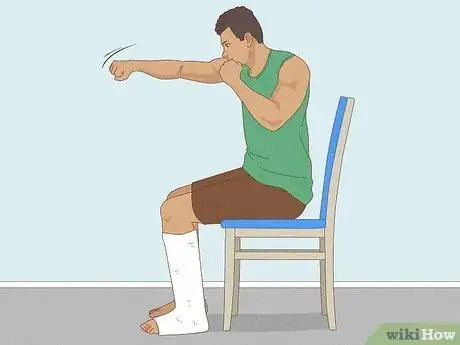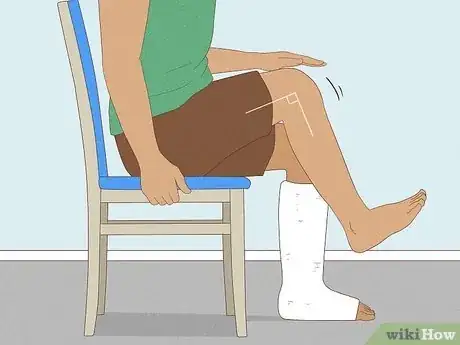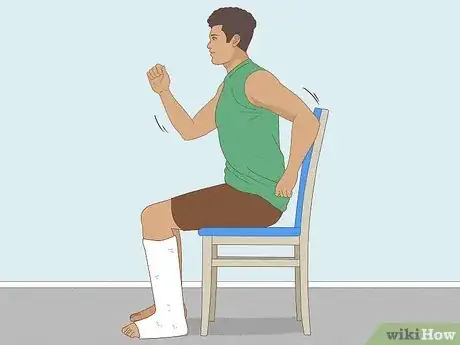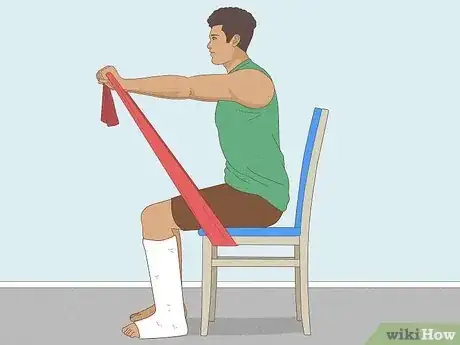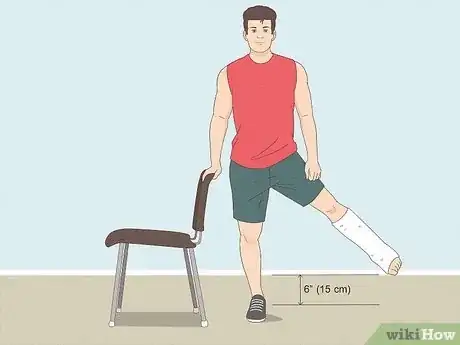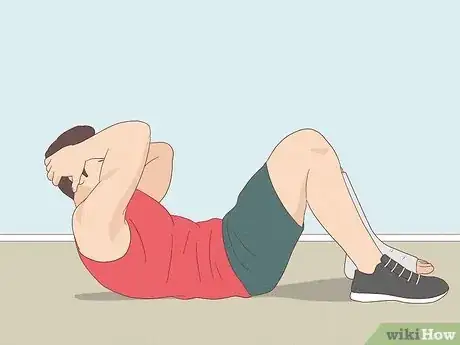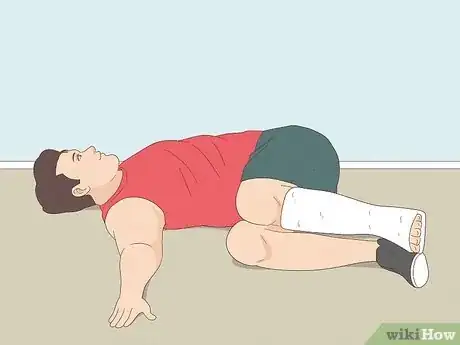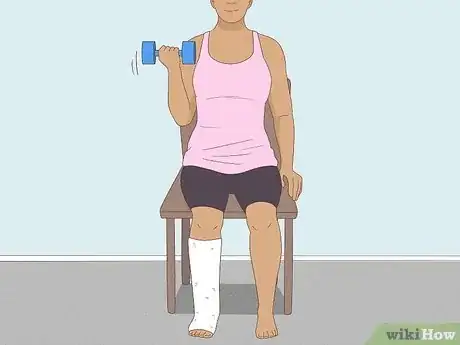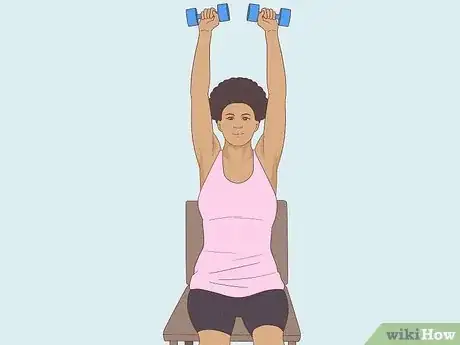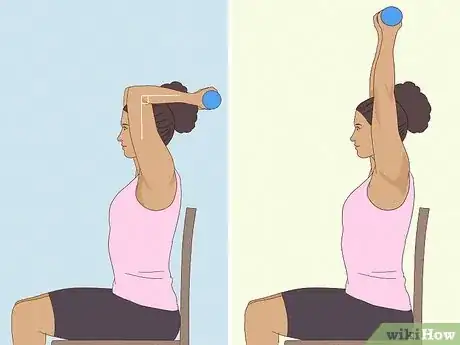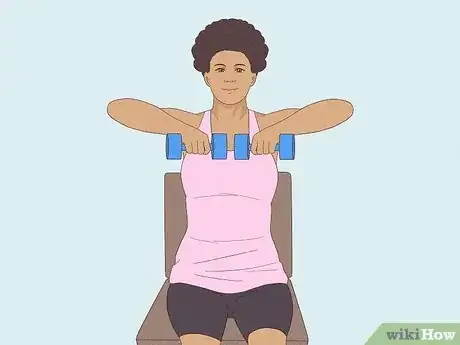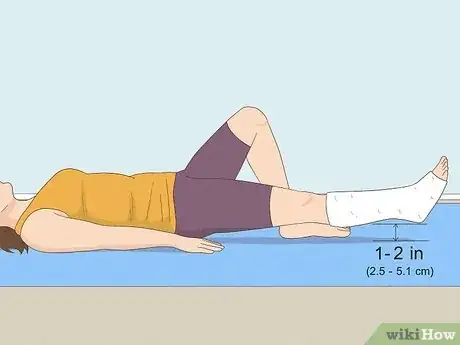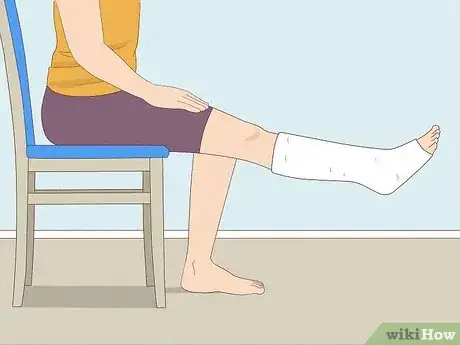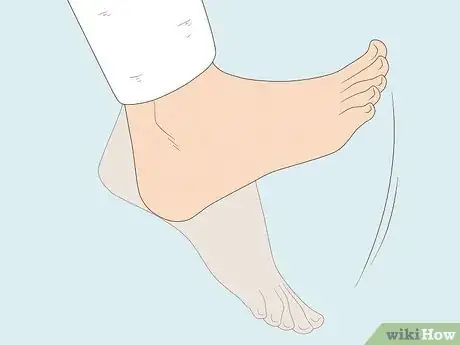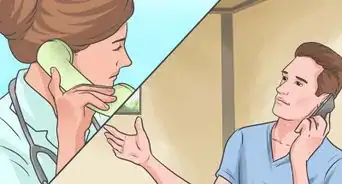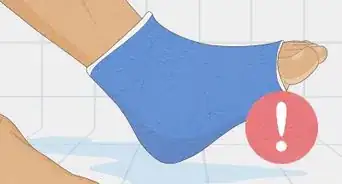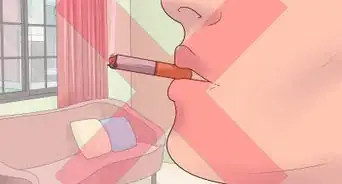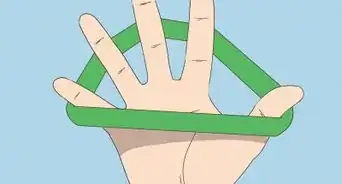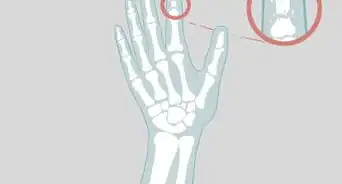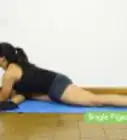This article was medically reviewed by Jonas DeMuro, MD and by wikiHow staff writer, Hannah Madden. Dr. DeMuro is a board certified Pediatric Critical Care Surgeon in New York. He received his MD from Stony Brook University School of Medicine in 1996. He completed his fellowship in Surgical Critical Care at North Shore-Long Island Jewish Health System and was a previous American College of Surgeons (ACS) Fellow.
There are 11 references cited in this article, which can be found at the bottom of the page.
This article has been viewed 180,818 times.
When you have a broken leg, keeping fitness at the forefront of your life can take a little bit of modification. Fortunately, there are lots of ways you can exercise while your leg is in a cast or you’re using crutches. In this article, we’ll tell you exactly which exercises to use to target the main muscle groups of your body, all while keeping your injured leg safe. If you’re concerned about any of these exercises or they cause your injured leg pain, talk to your doctor or physical therapist.
Steps
Cardio Exercises
-
1Try seated air punches. Sit in a chair with your feet flat on the floor and your back straight. Pretend like there’s a punching bag right in front of you and start punching, alternating your right and left hand.[1] Try to do about 25 reps, or as many punches as you can before you get tired.
- The goal of a cardio exercise is to get your heartrate up. Keep your movements fluid and quick to quicken your breathing and start to sweat.
-
2Do some knee taps. Sit in a chair with your feet on the floor and your back straight. Lift your left leg off the ground, keeping your knee bent at a 90-degree angle to the floor. Tap your knee with your right hand as it’s in the air. Then, switch legs.[2]
- Try doing this exercise for about 5 minutes, or until your heart rate has increased.
- If you’re wearing a full leg cast (meaning you can’t bend your knee), just do knee taps on your non-broken leg.
Advertisement -
3Try arm swings. Sit in a chair with your posture upright and your feet flat. Keeping your elbows bent, swing your arms back and forth, like you’re running in place.[3] Do this for about 5 minutes, or until you get tired.
- You can swing your arms both in the same direction, or do alternate directions.
-
4Do chest presses with a resistance band. Sit in a chair and wrap a resistance band underneath the seat of the chair. Hold either end of the band in each hand, with your palms facing forward. Press the band away from yourself, keeping your hands held at chest height. Do this for 25 to 30 reps, or until you start feeling tired.[4]
- Make sure the resistance band is fully secured beneath your chair. If it slips out from underneath the chair, it could hit your body.
- Choose a resistance band that’s right for your strength level. Most beginners start out with the lowest resistance band.
Ab and Core Exercises
-
1Try a standing leg lift to target your obliques. Stand next to a chair with your good leg (the non-broken one) closest to the chair. Hold the chair with one hand for stability, and slowly raise your broken leg out to the side until it’s about 6 inches (15 cm) off the floor. Lower your leg back down, then repeat this 7 to 9 times.[5]
- As you raise and lower your legs, engage your core by squeezing your abs and your obliques.
-
2Try some crunches to engage your lower abs. Lie flat on the floor with your legs bent and knees pointing toward the ceiling. If your leg is in a full cast, keep your leg straight instead of bending it. Put your hands behind your head to support your neck, and engage your abs to lift your shoulders off the ground.[6] Do crunches 10 to 20 times, or until your abs are fatigued.
-
3Do a segmental rotation to target your upper abs. Lie flat on the ground with your legs bent and your knees pointing up. If you are in a full leg cast, keep your leg straight instead of bending it. Engage your abs and let your knees fall to 1 side, going as far as you can while keeping your back flat on the ground. Hold the position for 3 deep breaths, then repeat on the other side.[7]
- Try doing this exercise 5 to 10 times, or until your ab muscles are fatigued.
Arm Exercises
-
1Engage your biceps with a seated bicep curl. Sit in a chair with your legs in a comfortable position and your feet flat on the ground. Grab a dumbbell in 1 hand and curl it up toward your shoulder, engaging your bicep the entire time. Slowly lower the dumbbell back down to repeat 1 repetition.[8]
- Try doing 8 to 10 repetitions to start before moving onto your other arm.
- Most arm dumbbell exercises can be converted into a seated position. If you have a favorite arm exercise you’d like to try, see if you can do it while sitting down!
-
2Try a seated overhead press to work your shoulders. Grab a dumbbell in each hand and lift them up to about shoulder height. Slowly lift your arms upward, keeping your palms facing forward, until your arms are straight. Lower the dumbbells back down to chest-height for 1 rep.[9]
- Try doing 15 repetitions to start.
- The weight of your dumbbells is up to you. If you’re a beginner, go for 5 pounds (2.3 kg) or 10 pounds (4.5 kg) to start.
-
3Do a seated tricep extension to target the back of your arms. While seated, hold a dumbbell in each hand with your palms facing behind you. Lift your weights straight up, bending your elbows at a 90-degree angle. Keeping your elbows in the same position, slowly straighten your arms and engage your triceps. Then, slowly return to your starting position to work your triceps.[10]
- Do this exercise 15 times to start out with, and add more as you get stronger.
-
4Work your arms, shoulders, and back with a seated upright row. While sitting in a chair, hold a dumbbell in each hand with your palms facing your legs. Slowly lift the dumbbells to shoulder-level, letting your elbows point outward. Engage your back to hold the position for a few seconds, then lower back down to do 1 rep of a dumbbell row.[11]
- Try to do at least 15 repetitions. If you feel up to it, you can rest and then go for 15 more reps.
Leg Exercises
-
1Strengthen your thigh with leg lifts. Lie flat with your good leg bent and your broken leg straight out. Raise your broken leg 1 to 2 in (2.5 to 5.1 cm) off the ground, then hold it for 2 to 3 seconds. Slowly lower your leg back down, then repeat this up to 10 times.[12]
- Strengthening the muscles around your broken leg may be able to help it heal faster.
- You can do this exercise up to 4 times per day.
-
2Engage your quads with a knee bend. Sit in a chair with your feet flat on the ground and your back straight. Straighten 1 leg out and lift it off the ground as high as you can, then hold it for 5 seconds. Repeat this exercise 10 times on each leg.[13]
- This is a great alternative to squats you can do while your leg heals.
-
3Keep your ankles strong with ankle rotations. Since you aren’t walking on your leg for a few weeks (or months), it’s important to keep your ankles in good shape. Sit in a chair with your feet in a comfortable position and slowly move your ankle up and down. Try to do this at least 10 times.[14]
- If your broken bone is near your ankle, ask your doctor about this exercise before you do it.
Warnings
- If any exercises hurt your leg, stop doing them right away.⧼thumbs_response⧽
References
- ↑ https://www.helpguide.org/articles/healthy-living/chair-exercises-and-limited-mobility-fitness.htm
- ↑ http://allactive.co.uk/wp-content/uploads/2016/04/Chair-based-aerobic-exercises-AllActive-Information-Guide.pdf
- ↑ http://allactive.co.uk/wp-content/uploads/2016/04/Chair-based-aerobic-exercises-AllActive-Information-Guide.pdf
- ↑ https://www.helpguide.org/articles/healthy-living/chair-exercises-and-limited-mobility-fitness.htm
- ↑ https://www.health.harvard.edu/exercise-and-fitness/easy-exercises-to-shore-up-your-core
- ↑ https://www.newtrier.k12.il.us/site/handlers/filedownload.ashx?moduleinstanceid=5679&dataid=6558&FileName=Abdominal%20and%20Core.pdf
- ↑ https://www.mayoclinic.org/healthy-lifestyle/fitness/multimedia/core-strength/sls-20076575?s=8
- ↑ https://www.youtube.com/watch?v=zs618MVIsG4
- ↑ https://www.youtube.com/watch?v=b5JzUH8gsOg
- ↑ https://www.youtube.com/watch?v=_gsUck-7M74
- ↑ https://www.nhs.uk/live-well/exercise/strength-and-flexibility-exercises/sitting-exercises/
- ↑ https://www.wihb.scot.nhs.uk/wp-content/uploads/2020/03/Advice-for-patients-in-a-below-knee-cast-1.pdf
- ↑ https://www.wihb.scot.nhs.uk/wp-content/uploads/2020/03/Advice-for-patients-in-a-below-knee-cast-1.pdf
- ↑ https://www.thh.nhs.uk/documents/_Patients/PatientLeaflets/blood/Preventing_blood_clots.pdf
About This Article
Before you try to exercise with a broken leg, run it by your doctor or physical therapist first to make sure it's safe. If they give you the go ahead, continue your usual upper body workout while being mindful of your leg. You can also do pull-ups using a chin bar, crunches, and push-ups. Additionally, get in a cardio workout by doing aerobic exercises while seated in a chair. For example, you can sit down in a chair and alternate between doing arm circles and arm punches. For tips from our Medical co-author, like how to do one-leg squats with a broken leg, keep reading!
